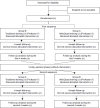Effect of WebQuest-based education on critical thinking and academic self-efficacy of midwifery students: Study protocol of a randomized, controlled crossover trial
- PMID: 38333154
- PMCID: PMC10852155
- DOI: 10.4103/jehp.jehp_1662_22
Effect of WebQuest-based education on critical thinking and academic self-efficacy of midwifery students: Study protocol of a randomized, controlled crossover trial
Abstract
Background and aim: Critical thinking fills the gap between theoretical and clinical teaching and increases the power of clinical decision-making. WebQuest is an innovative, learner-centered, and effort-driven learning approach that uses computer technology to engage and motivate learners. In WebQuest, learners are compelled to use the latest information available on the web as a tool to promote higher levels of thinking. However, we did not find a study that used WebQuest to improve students' critical thinking and academic self-efficacy. The aim of this study will be to investigate the effect of WebQuest-based education on the critical thinking of midwifery students.
Materials and methods: This superiority randomized, controlled crossover trial will be carried out among fifth-semester undergraduate midwifery students. Participants will be allocated to one of two event groups (A and B) using block randomization. In the first sequence (FS) (four weeks) of study, both groups will simultaneously attend two different education groups (WebQuest and traditional). During the FS, WebQuest will be used to teach group A participants, while group B participants will be treated as the control group (CG) and be taught using a traditional presentation. In the second sequence (SS), the interventions will be crossed over. Participants in both groups will complete the sociodemographic questionnaire, the California Critical Thinking Skills Test (CCTST), the California Critical Thinking Disposition Inventory (CCTDI), and the Academic Self-Efficacy Beliefs Questionnaire (ASEBQ) once before the first sequence of the study, during the washout period, and at the end of the second sequence of the study. The teaching satisfaction questionnaire will be completed at the end of the study.
Discussion: The results of this study can be used as a basis for teaching midwifery students using WebQuest as a new teaching method.
Keywords: Academic self-efficacy; WebQuest; critical thinking; education; midwifery; traditional.
Copyright: © 2023 Journal of Education and Health Promotion.
Conflict of interest statement
There are no conflicts of interest.
Figures
References
-
- Victor-Chmil J.Critical thinking versus clinical reasoning versus clinical judgment: Differential diagnosis Nurse Educ 20133834–6 - PubMed
-
- Akhoundzadeh K, Hosseini A, Salehi Sh.Crirtical Thinking and Clinical Dectision Making in Nursing. 1st ed. Isfahan: Isfahan University of Medical Science; 2006
-
- Peeters MJ, Zitko KL, Schmude KA.Development of critical thinking in pharmacy education Innov Pharm 201671–9 . doi: 10.24926/iip.v7i1.415
-
- World Federation for Medical Education Basic Medicak Education, WFME Global Standards for Quality Improvment Denmark: WFME office: University of Copenhange; 2003
LinkOut - more resources
Full Text Sources
Miscellaneous



